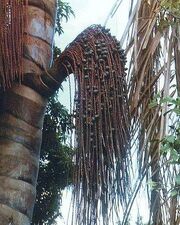| ||||||||||||
The segamai (Machiguenga: "Oenocarpus fibers") is a cryptid reported from the the Peruvian Amazon near the Vilcabamba mountain range, described as a fearsome slothlike animal. It is usually considered a regional name for the mapinguari on account of its almost identical description.[1]
Description[]

The segamai's matted fur is compared to the fibers on the trunk of the Oenocarpus bataua palm.
It is described by modern Matsigenka as a cow-sized animal which can walk both quarupedally and bipedally, with dark matted fur (specifically said to resemble the fibers surrounding the leaf stems of an Oenocarpus bataua palm) and a long snout "similar to" a giant anteater's. It has been compared to a horse[2] and to a very large and hairy giant anteater, with large red eyes.[3] It is said to live in caves and rocky areas[3] in the remote cloud and foothill forests, where it feeds on Cyclanthaceae plants and palm piths. The Matsigenka are terrified of it due to its reputedly aggressive behaviour, and it has a number of alleged characteristics in common with the mapinguari: it is said to be impervious to bullets, has a terrible roar (written phonetically as hmmmmmmmm hmmmmmmmm[3]), and supposedly generates an odour which stupefies or knocks out anyone who comes close to it.[1] According to anthropologist Glenn Shepard Jr., the Matsigenka see it as merely another animal inhabiting the forest,[4] though in a 2002 study he categorized it as a "demon with matted fur" in the mythology of the Machiguenga.[5]
Sightings[]
Undated[]
During an interview for the TV show Beast Man, Glenn Shepard Jr. told Pat Spain that the Matsigenka reported seeing large claw marks on trees, which they believed had been made by the segamai.[4]
~1976[]
A sighting made from a distance was reported to have occurred in around 1976, and as of 2001, the Matsigenka insisted that the segamai still lived in certain areas of the forest.[1] However, in 2011, it was described as being no longer seen.[3]
Theories[]
- See also: Mapinguari§Theories
In 1997, Glenn Shepard Jr. suggested to some Matsigenka who told him about the segamai that it might be a bear: the Matsigenka , who knew spectacled bears (Tremarctos ornatus) well, "expressed great surprise and affirmed that the two animals are completely different".[6] One of the tribe matter-of-factly told him that he had seen a segamai at Lima's Natural History Museum when he was a student,[1] and when Shepard checked, he discovered that the museum had a diorama featuring a model of a giant ground sloth.[7] However, the student had never seen the segamai himself, and had previously assumed it to be mythical.[1]
Similar cryptids[]
The segamai is equated with the mapinguari, and so is by extension equated with the kida harara, owhuama, jucucu, and other alleged Amazonian ground sloths.
Notes and references[]
- ↑ 1.0 1.1 1.2 1.3 1.4 "Segamai: Survival of the Pleistocene ground sloth?," Biological and Social Assessments of the Cordillera de Vilcabamba, Peru (RAP Working Papers 12, June 2001)
- ↑ Baer, Gerhard & Snell, Wayne W. "An Ayahuasca Ceremony Among the Matsigenka (Eastern Peru)," Zeitschrift für Ethnologie, Vol. 99, pp. 63-80
- ↑ 3.0 3.1 3.2 3.3 Peralta, Giancarlo Gallegos (2001) Diccionario Matstigenka-Castellano
- ↑ 4.0 4.1 "Nightmare of the Amazon". Beast Man: Series 1, Episode 2.
- ↑ Shepard, Glenn (2002) Three Days for Weeping: Dreams, Emotions, and Death in the Peruvian Amazon
- ↑ Oren, David C. "Does the Endangered Xenarthran Fauna of Amazonia Include Remnant Ground Sloths?," Edentata (June 2001)
- ↑ Rohter, Larry "A Huge Amazon Monster Is Only A Myth. Or Is It?," The New York Times (8 June 2007); online at nytimes.com [Accessed 19 January 2014]
